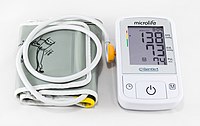
Photo from wikipedia
Background: The COVID-19 pandemic has accelerated adoption of remote consulting in healthcare. Despite opportunities posed by telemedicine, most hypertension services in Europe have suspended ambulatory blood pressure monitoring (ABPM). Methods:… Click to show full abstract
Background: The COVID-19 pandemic has accelerated adoption of remote consulting in healthcare. Despite opportunities posed by telemedicine, most hypertension services in Europe have suspended ambulatory blood pressure monitoring (ABPM). Methods: We examined the process and performance of remotely delivered ABPM using two methodologies: firstly, a Failure Modes and Effects Analysis (FMEA) and secondly, a quantitative analysis comparing ABPM data from a subgroup of 65 participants of the Screening for Hypertension in the INpatient Environment (SHINE) diagnostic accuracy study. The FMEA was performed over seven sessions from February to March 2021, with a multidisciplinary team comprising a patient representative, a research coordinator with technical expertise and four research clinicians. Results: The FMEA identified a single high-risk step in the remote ABPM process. This was cleaning of monitoring equipment in the context of the COVID-19 pandemic, unrelated to the remote setting. A total of 14 participants were scheduled for face-to-face ABPM appointments, before the UK March 2020 COVID-19 lockdown; 62 were scheduled for remote ABPM appointments since emergence of the COVID-19 pandemic between November 2020 and August 2021. A total of 65 (88%) participants completed ABPMs; all obtained sufficient successful measurements for interpretation. For the 10 participants who completed face-to-face ABPM, there were 402 attempted ABPM measurements and 361 (89%) were successful. For the 55 participants who completed remote ABPM, there were 2516 attempted measurements and 2214 (88%) were successful. There was no significant difference in the mean per-participant error rate between face-to-face (0.100, SD 0.009) and remote (0.143, SD 0.132) cohorts (95% CI for the difference -0.125 to 0.045 and two-tailed P-value 0.353). Conclusions: We have demonstrated that ABPM can be safely and appropriately provided in the community remotely and without face-to-face contact, using video technology for remote fitting appointments, alongside courier services for delivery of equipment to participants.
Journal Title: Wellcome Open Research
Year Published: 2022
Link to full text (if available)
Share on Social Media: Sign Up to like & get
recommendations!